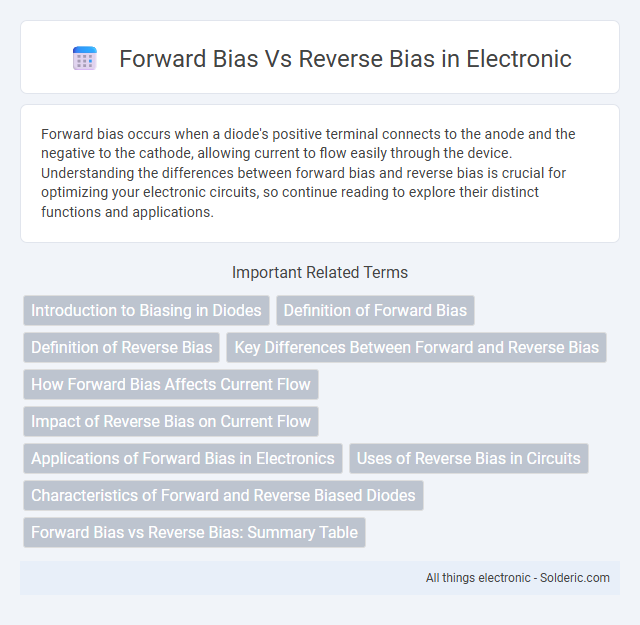Forward bias occurs when a diode's positive terminal connects to the anode and the negative to the cathode, allowing current to flow easily through the device. Understanding the differences between forward bias and reverse bias is crucial for optimizing your electronic circuits, so continue reading to explore their distinct functions and applications.
Comparison Table
| Aspect | Forward Bias | Reverse Bias |
|---|---|---|
| Definition | Positive voltage applied to the p-side relative to the n-side of a diode | Positive voltage applied to the n-side relative to the p-side of a diode |
| Current Flow | Allows significant current flow | Blocks current, only leakage current flows |
| Depletion Region | Narrows, reducing barrier potential | Widens, increasing barrier potential |
| Voltage Polarity | Positive on p-side, negative on n-side | Positive on n-side, negative on p-side |
| Application | Used in rectifiers, LED operation | Used in voltage regulation, photodiodes |
| Energy Barrier | Decreases energy barrier for carrier movement | Increases energy barrier for carrier movement |
| Charge Carrier Movement | Majority carriers flow across junction | Minority carriers dominate leakage current |
Introduction to Biasing in Diodes
Biasing in diodes involves applying an external voltage to control current flow, crucial for semiconductor device operation. Forward bias occurs when the positive terminal of the power supply connects to the diode's anode, reducing the barrier potential and allowing current passage. Reverse bias reverses this connection, increasing the barrier potential and preventing current flow, except for a minimal leakage current.
Definition of Forward Bias
Forward bias occurs when the positive terminal of a voltage source is connected to the p-type semiconductor and the negative terminal to the n-type semiconductor in a diode. This connection reduces the width of the depletion region, allowing charge carriers to flow easily across the junction. As a result, current flows through the diode, enabling its conductive state.
Definition of Reverse Bias
Reverse bias occurs when the voltage applied across a diode is in the direction that increases the width of the depletion region, preventing current flow. In this condition, the p-type semiconductor is connected to the negative terminal and the n-type semiconductor to the positive terminal, creating a high-resistance state. Reverse bias is essential in applications like voltage regulation, photodiodes, and protection circuits due to its ability to block current except for a small leakage.
Key Differences Between Forward and Reverse Bias
Forward bias occurs when the positive terminal of a power source is connected to the p-type semiconductor and the negative terminal to the n-type, allowing current to flow easily through the diode. Reverse bias involves connecting the positive terminal to the n-type and the negative terminal to the p-type, creating a depletion region that blocks current flow. The key difference lies in the direction of current flow and the widening or narrowing of the depletion region, which controls the diode's conductivity.
How Forward Bias Affects Current Flow
Forward bias reduces the barrier potential of a semiconductor junction, allowing charge carriers to move freely across the junction. This results in an exponential increase in current flow as the applied voltage surpasses the threshold voltage. Your electronic devices rely on this principle to control current flow efficiently in diodes and transistors.
Impact of Reverse Bias on Current Flow
Reverse bias significantly restricts current flow in a diode by expanding the depletion region, which increases the barrier potential and prevents charge carriers from crossing the junction. This results in an extremely low leakage current, often in the nanoampere range, ensuring minimal power dissipation in electronic circuits. Your electronic device relies on this property to block unwanted current and protect sensitive components.
Applications of Forward Bias in Electronics
Forward bias in electronics enables current flow by reducing the potential barrier at a semiconductor junction, making it essential in diode rectifiers for converting AC to DC power. It is crucial in LED lighting, where forward bias allows electrons to recombine with holes and emit light efficiently. Forward bias also facilitates transistor operation in amplifiers and switches by controlling current flow through semiconductor junctions.
Uses of Reverse Bias in Circuits
Reverse bias in semiconductor diodes is primarily used in circuits for applications like voltage regulation, signal modulation, and protection. It enables Zener diodes to maintain a stable reference voltage in voltage regulator circuits by operating in the breakdown region without damage. Reverse bias also ensures minimal current flow, which protects sensitive components from voltage spikes and allows photodiodes to detect light efficiently by increasing the depletion region width.
Characteristics of Forward and Reverse Biased Diodes
Forward biased diodes exhibit low resistance and allow current to flow easily once the threshold voltage is surpassed, typically around 0.7V for silicon diodes. Reverse biased diodes present high resistance, blocking current flow except for a minimal leakage current, until the breakdown voltage is reached. These distinct characteristics are crucial for diode applications in rectification, voltage regulation, and signal modulation.
Forward Bias vs Reverse Bias: Summary Table
Forward bias allows current flow by reducing the potential barrier across a p-n junction, enabling majority charge carriers to move freely. Reverse bias increases the potential barrier, preventing current flow and causing only a minimal leakage current due to minority carriers. Key differences include direction of current flow, voltage polarity, junction behavior, and applications such as rectification in forward bias and voltage regulation in reverse bias.
Forward Bias vs Reverse Bias Infographic

 solderic.com
solderic.com